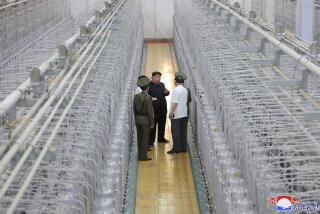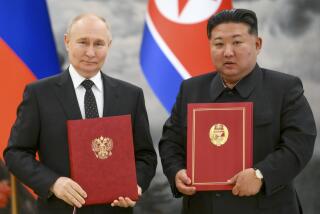Ground, but Perhaps Not Ice, Broken in N. Korea
- Share via
KUMHO, North Korea — Amid the smiles and pleasantries of Tuesday’s groundbreaking here for a multinational nuclear reactor project, a prickly sense of North Korean pride was also on display.
Construction of two nuclear reactors that an international consortium has pledged to build in North Korea is starting out 18 months behind schedule, and Tuesday’s ceremonies at the site have not erased North Korean fears that the plants might never be completed, said Kim Byong Gi, head of the project for North Korea.
“We think this groundbreaking ceremony has taken place too late,” Kim told reporters after the event, which was marked by speeches and a groundbreaking explosion of earth that sent puffs of pink, green, orange and yellow smoke belching from a hillside. Even though the launch of construction “gives us much relief,” the long delay means that “Korean people have become more and more doubtful about the actual implementation of this project,” he said.
The U.S.-led consortium is building two 1,000-megawatt light-water nuclear reactors as part of a 1994 deal under which North Korea agreed to shut down a different kind of nuclear power plant--one producing plutonium that Washington suspected might be used to make nuclear bombs. The reactors promised under the agreement do not produce materials that could be easily turned into weaponry.
In shuttering the old reactor, North Korea has suffered a “huge economic loss” to carry out its part of the deal, Kim said. “The [new] project is not a gift. It is not a donation,” he stressed.
Kim also demanded that the United States lift its economic sanctions against North Korea and improve relations with the Communist regime in Pyongyang.
Kim’s remarks, which came at the close of a day of mutual congratulation by the parties to the landmark Korean Peninsula Energy Development Organization, or KEDO, project, highlighted the perception gap that persists even after years of collaboration.
A source close to the negotiations retorted that the delays were of North Korea’s own making. The consortium was prepared to break ground last fall, but a North Korean submarine ran aground in South Korea in September, triggering a diplomatic crisis and a suspension of KEDO activity.
One of the longest delays in the negotiations, the source added, was the months that it took North Korea to accept a South Korean type of reactor as the model for those to be built here.
South Korea is paying most of the cost of the $5-billion project, with Japan also paying a significant share. A South Korean firm, Korea Electric Power Corp., or KEPCO, is the lead contractor.
The United States has contributed $80 million to $90 million to the project so far. The consortium is also providing North Korea with 500,000 tons of fuel oil annually until the nuclear plants begin operation.
In return, Pyongyang pledged to freeze its nuclear program and to submit its nuclear facilities to full inspections by the International Atomic Energy Agency to ensure that North Korea does not have a nuclear bomb or the means to produce one.
The deadline for North Korea to comply is linked to progress on the new reactors.
Stephen Bosworth, KEDO’s American executive director, and Paul Cleveland, the U.S. ambassador to KEDO, told journalists here that the biggest obstacle in their tortuous negotiations with Pyongyang--apart from the potentially explosive relations between North and South Korea--has been the North’s extreme isolation and lack of trust.
Typical of the obstacles was the North’s unwillingness to allow engineers and equipment to travel directly from the South. The ship that carried the VIPs and journalists to the ceremony took 15 hours instead of five because it had to make a wide swing into international waters so as not to come directly from South Korean waters. The delegation sailed for the South this morning.
Conditions for foreign workers at the site are not easy either, due largely to the isolation of this remote place on North Korea’s northeast coast. They are not allowed contact with any locals except those working in the housing facility or on the construction site.
Park Young Chul, the South Korean director of KEPCO’s construction division for the project, said South Korean workers are already complaining of boredom. “It’s a big jail without a fence.”
KEPCO officials said they will install billiard halls, karaoke parlors and satellite TV to liven things up.
Times staff writer David Holley in Tokyo contributed to this report.
More to Read
Sign up for Essential California
The most important California stories and recommendations in your inbox every morning.
You may occasionally receive promotional content from the Los Angeles Times.













